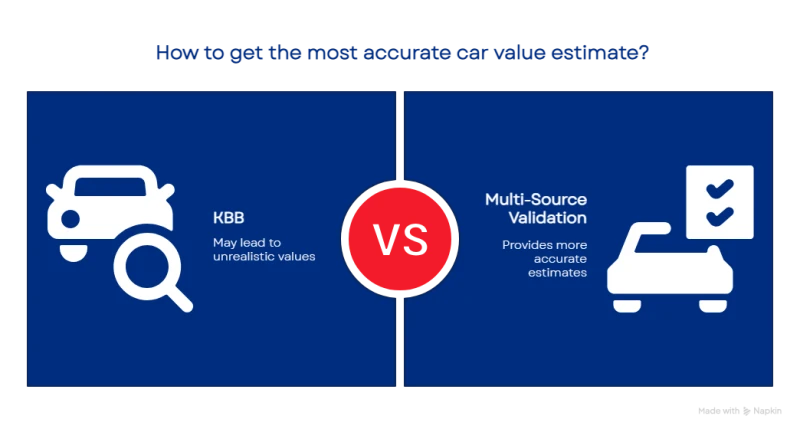Relying solely on Kelley Blue Book prices can result in pricing errors. If the number is too high or too low, you may lose time or money, especially when considering cars that hold their value.
This article explains how KBB pricing works, where it often falls short, and how to get a more accurate appraisal of vehicle value when buying or selling a car. It may help you avoid common mistakes and provide better information for making a confident decision.
What You’ll Learn
By the end of this article, you’ll understand:
How Kelley Blue Book calculates car values and why its estimates may not match your local market
Why dealers often offer less than the KBB price
What other tools and sources to use alongside KBB to get a more accurate value
Summary
Kelley Blue Book has been the go-to source for car valuations since 1926, but is it accurate in today's market? Here's what you need to know about KBB's reliability and how to use it effectively for buying or selling cars in the United States.
How KBB Actually Works
Kelley Blue Book collects data from over 250 sources, including dealership sales, auctions, private transactions, and vehicle registrations. Their proprietary algorithms analyze this information alongside market trends, seasonal factors, and regional conditions across more than 100 geographic areas. These values are updated weekly to reflect current market conditions.
The Accuracy Question: Mixed Results
Where KBB Tends to Be Accurate
General market trends: Provides a solid baseline for understanding relative vehicle values
Trade-in estimates: Often close to what dealers offer, especially for mainstream vehicles
Regional variations: This accounts for geographic price differences across the U.S.
Where KBB Often Falls Short
Real-world selling prices: Private sellers frequently get $1,000-$3,000 more than KBB estimates
High-demand vehicles: KBB often undervalues sought-after models like Toyota 4Runners, Jeep Wranglers, and certain trucks
Unique conditions: Doesn't account for exceptional maintenance, upgrades, or local market quirks
Industry Professional Perspectives
Car sales professionals are notably skeptical of KBB's accuracy. As one Reddit user in car sales noted: "KBB is borderline useless in today's world... KBB hasn't been 'accurate' in the 20+ years I've been in the industry". The consensus among dealers is that KBB provides a guide, but actual market prices often differ significantly.
KBB vs. Competitors: Which Is More Accurate?
Edmunds: Generally considered more accurate for buyers because it uses more real-world transaction data. It better reflects what you'll pay at dealers.
NADA Guides: Often used by banks and credit unions for loan valuations. Sometimes more conservative than KBB.
Real-time market research: Checking actual listings on Autotrader, Cars.com, and local markets often provides the most accurate pricing.
How to Use KBB Effectively
For Sellers
Use KBB as a starting point, not as a final authority.
Research actual listings for your make/model in your area.
Get multiple appraisals from CarMax, Carvana, and local dealers.
Consider private sales - often yield $1,000+ more than KBB estimates.
For Buyers
Use the KBB Fair Purchase Price as your target.
Compare with Edmunds for potentially more accurate dealer pricing.
Factor in local market conditions - high-demand areas may exceed KBB values.
KBB provides a valuable baseline, but it isn't perfectly accurate. It's best used as one tool in a broader research approach rather than as the definitive source. The platform tends to:
Undervalue high-demand vehicles and well-maintained cars
Overestimate values for damaged or problematic vehicles
Lag rapidly changing market conditions
Average in dealer profit margins, potentially lowering estimates
Better Approach: Multi-Source Validation
For the most accurate car valuation:
Check KBB, Edmunds, and NADA values.
Research actual listings in your local market.
Get instant offers from online buyers (CarMax, Carvana, Vroom).
Consider professional appraisals for unique or high-value vehicles.
Remember: In today's volatile used car market, no single source provides perfect accuracy. KBB remains a respected starting point, but savvy buyers and sellers validate its estimates against real-world market data before making decisions.
The truth is that KBB is moderately accurate for average vehicles in typical conditions, but market forces, regional demand, and individual vehicle characteristics can create significant variations from its estimates.
Why KBB Values Don’t Always Match Real-World Prices
Following KBB alone can be like following a recipe without accounting for your kitchen. You may buy the right parts, follow the steps, and still end up with a value that does not reflect your market.
The condition of your car, current demand in your area, time of year, and even gas prices all affect what someone is willing to pay. KBB does not factor in all of these variables as they happen.
Before you assume the number on the screen reflects what a dealer will offer, keep reading. It may save you from a common mistake.
How Kelley Blue Book Calculates Car Values
Kelley Blue Book assigns vehicle values using a national data model. The estimates it provides are not based on real-time transactions in your ZIP code, but on broader trends pulled from many sources. These values are meant to be general guides, not exact figures.
The company gathers data from a range of sources:
Dealer retail sales
Wholesale auctions
Lease and fleet transactions
Private party sales
That data feeds into a pricing model that factors in mileage, trim level, equipment, condition, and market timing. Values are updated once per week.
The user selects condition ratings. These include categories such as excellent, very good, reasonable, and fair. Most users select a higher condition rating than the vehicle deserves, which can skew the estimated value.
KBB applies regional adjustments, but these cover large areas rather than specific cities or neighborhoods. A car in Durham may receive the same value as one in another part of the state, even if buyer interest is different.
Trade-in values from KBB often include reductions for dealer reconditioning and resale costs. These internal adjustments may not be visible to the user, which can lead to lower offers than expected.
The Accuracy Question: Mixed Results
Kelley Blue Book can be useful in some situations. It provides a broad view of pricing trends, helping to compare vehicles within a category. For example, it is often reliable for standard, unmodified cars with average mileage. In these cases, its trade-in estimates may be close to what a dealer offers.
There are also areas where KBB’s numbers fall short. Some of the most common issues include:
Private-party values are often too low compared to actual selling prices
High-demand models like pickup trucks or certain SUVs are usually undervalued
Custom features, recent maintenance, or local demand are not reflected accurately
Price changes in fast-moving markets take time to show up in KBB updates
These gaps are especially noticeable in regions where vehicle demand shifts quickly. Local dealers and private buyers often rely more on current listings and in-person evaluations than national pricing tools. While KBB is still widely used, most professionals treat it as a rough reference, not a final number.
What the Industry Thinks
Within the automotive industry, Kelley Blue Book is often viewed as a customer-facing tool rather than a pricing authority. Many dealerships reference it because consumers expect to see it, but they do not rely on it to set actual purchase offers.
Used-vehicle managers prefer sources that reflect current sales activity. This includes recent auction data, retail sales reports, and pricing from local listings. These sources provide more accurate insights into what vehicles are selling for in the current market.
KBB values are often adjusted internally to account for reconditioning costs, market conditions, and turnaround time. These adjustments are not visible to the consumer. As a result, dealers may view KBB as incomplete when evaluating real-world pricing.
Most professionals treat KBB as one tool among several. It may help start a conversation with a customer, but it is rarely used to finalize a number.
KBB vs. Competitors: Which Is More Accurate?
Kelley Blue Book is widely recognized, but it is not the only source available for vehicle valuations. Several other platforms offer different pricing models, each with its strengths.
Edmunds is often considered more reflective of actual dealership pricing. Its values are based on actual transactions and tend to align more closely with what buyers pay on dealer lots. Edmunds also includes detailed trim-level adjustments and recent market shifts, which can result in estimates that match real offers more closely.
NADA Guides, used by many lenders and financial institutions, offer conservative estimates. These are not always helpful for private sales, but they are useful when financing is involved, as banks often refer to them for loan decisions.
Live listings from platforms like Autotrader, Cars.com, Facebook Marketplace, and Craigslist provide real-time pricing. These listings can show what similar vehicles are being offered in your area. They reflect current demand, condition, and pricing expectations from both sellers and buyers.
Each of these tools uses different data inputs and serves various purposes. For the most accurate picture, it helps to compare across several sources rather than relying on one.
How to Use KBB Effectively
Kelley Blue Book can still be a helpful resource, but it works best when paired with additional research. How you use it depends on whether you are selling or buying.
For sellers, KBB is a good starting point. It provides a baseline for comparing against real offers. However, you should also:
Check current listings for similar vehicles in your ZIP code.
Request offers from online buyers like CarMax, Carvana, or local dealerships.
Consider a private sale if your vehicle is in strong condition.
Private party sales often bring in more than trade-in offers. In some cases, the difference can be between $1,000 and $3,000.
For buyers, the Fair Purchase Price on KBB can help guide negotiation. Still, it is essential to:
Compare values on Edmunds and dealership websites.
Adjust your expectations if you're shopping for a high-demand vehicle.
Confirm availability and final pricing directly with local sellers.
Using KBB alongside these tools helps you make more informed decisions, whether you're at the dealership or handling the sale yourself.
Better Strategy: Multi-Source Validation
No single pricing tool can reflect every factor that affects a vehicle’s market value. A better approach is to compare multiple sources and check real-time data.
For a more accurate estimate, combine values from:
Kelley Blue Book
Edmunds
NADA Guides
Then compare those figures to listings on local platforms. Look for vehicles with the same year, make, model, mileage, trim, and condition. This gives a clearer picture of what buyers in your area are paying and what sellers are asking.
If your vehicle is rare, heavily modified, or in above-average condition, a professional appraisal may help. This can also be useful when documentation is needed for legal, insurance, or loan purposes.
Instant online offers can also provide a reliable pricing baseline. They are often valid for a short time and reflect current wholesale and retail trends.
The more data points you review, the closer you’ll get to a real-world price. Using at least three sources is usually enough to understand what your car is worth in today’s market.
Final Thoughts
Kelley Blue Book can be a helpful starting point, but it should not be used in isolation. It provides a general sense of vehicle value, but often overlooks key pricing factors such as local demand, specific condition, and current market shifts.
Using multiple tools provides a more accurate estimate. Comparing KBB with platforms like Edmunds, NADA Guides, and real local listings helps you understand what a car is likely to sell for. If needed, online offers or appraisals can add another layer of clarity.
Whether you're buying or selling, informed decisions start with reliable data. Use more than one source and focus on what is happening in your area, not just national averages.
Need Help Shipping Your Car?
AmeriFreight Car Shipping is here to help you with transporting vehicles after a sale or purchase. Whether you're moving your car across the state or to another part of the country, our team can help you choose the right shipping option.
Reach out to learn how the process works and what to expect before scheduling your transport.
Frequently Asked Questions (FAQs)
What role do optional features and trim levels play in KBB's accuracy?
They can affect value, but KBB may not fully account for all options or local demand.
How often does KBB update its algorithms to reflect real-time market changes?
KBB updates its data weekly, not in real time.
Does KBB consider the average time a car sits on a dealer lot in its calculations?
No, this metric is not part of KBB’s published pricing model.
Should I bring my KBB printout to a dealership negotiation, and will it help?
It can help start the conversation, but dealers use their tools and local data.
Disclaimer: This article is for general informational purposes only and does not provide financial or valuation advice. For specific pricing decisions, consult a qualified professional or appraiser.






















